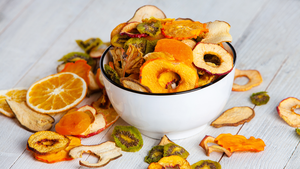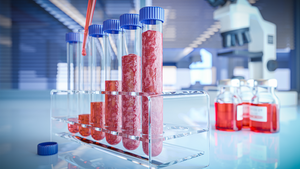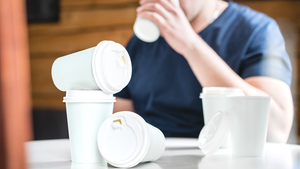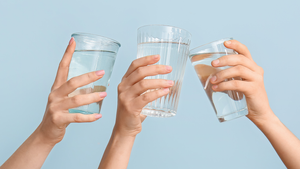Crafting commercial kombucha to meet consumer needs
Kombucha brands offer differentiation in the market with different formulation twists on the beverage with ancient tradtition, including upping the alcohol content for a “hard” option.
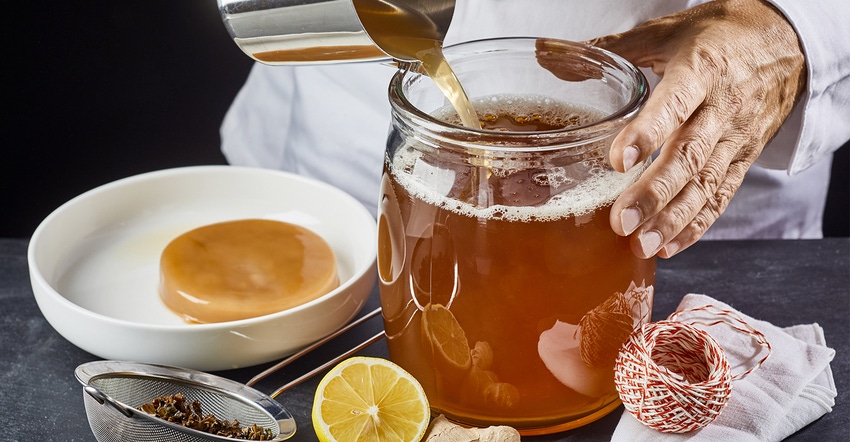
Kombucha at its simplest is green/black tea and sugar that’s been fermented with a SCOBY (symbiotic culture of bacteria and yeast). After several days of fermentation, the SCOBY is removed, flavors and inclusions are added, and the tea is sealed in an anaerobic container for the second fermentation. It’s been homemade for centuries—although its origins are unknown, it was likely first used in Manchuria (Northeast China) around 200 B.C. (Compr. Rev. Food Sci. Food Saf. 2014;13(4):538-550)—but commercial brewing has taken that traditional method in several directions.
Some brands, such as Health-Ade and GT’s, brew in small batches. “Health-Ade brews kombucha just like you would at home: in 2.5-gallon glass jars utilizing a SCOBY,” said Vanessa Dew, co-founder and chief sales officer, Health-Ade. The brand’s formula starts with brewing organic green and black tea sweetened with organic cane sugar. The brand pours the cooled tea into the jars along with a SCOBY and extra fermented Health-Ade kombucha to use as a starter. Then, it’s covered with clean T-shirt material and sits in a hot room for seven to 10 days for primary fermentation. The liquid is then blended with organic, cold-pressed juice and/or botanicals and extracts to flavor. It’s bottled and left for up to 10 more days for the second fermentation. From there, it is placed into cold storage and distributed.
“We have a very unique manufacturing process,” Drew said. “We are the only commercial kombucha brand brewing in glass (which prevents plastic leaching), and we brew in super small batches to ensure quality control.”
Similarly, “At GT's, we prefer to ferment in small five-gallon vessels, so our cultures are not very large (about 18 inches in diameter),” said GT Dave, founder and CEO at GT's Living Foods. “We differentiate ourselves by staying true to the traditional recipe of raw kombucha.”
Kombucha can be brewed in large batches as well. Kombucha brands that receive raw materials from BI Nutraceuticals ferment their beverages in large batches. The liquid product is dried, which removes the live bacteria, noted Randall Kreienbrink, vice president of marketing for The Martin Bauer Group USA, which acquired BI Nutraceuticals in March 2019. Culture is added back to powdered kombucha for the final formulation. This type of manufacturing method offers stability and standardized colony forming units (CFUs) of the live culture, Kreienbrink said. Plus, he added, the powder version won’t ferment into alcohol, so that concern is removed.
KÖE Organic Kombucha’s target consumer is mainstream, so the brand has a big desire for consistency, shelf stability and a standardized probiotic CFU count. The brand achieves this, along with safety measures, by pasteurizing its brew. The brand ferments organic black tea and organic cane sugar with a SCOBY in large 5,000-gallon batches for four months. After fermentation, the brand filters out the SCOBY to hinder further fermentation. KÖE adds Lactospore (Bacillus coagulans MTCC 5856, from Sabinsa Corp.) to ensure the probiotic counts meet label claims throughout the one-year shelf life without refrigeration. “People are looking for new ways to consume probiotics,” said Jared Smith, vice president of business development, KÖE Organic Kombucha, a Stratus Group company. From there, “We go through a pasteurization process, and the heat does not destroy the probiotics or denature the organic acids or polyphenols, so we are able to maintain that functionality and efficacy from fermentation all the way through pasteurization,” Smith added.
Sam Michini, vice president of marketing and strategy, Deerland Probiotics & Enzymes, noted an increased demand by many brands for adding probiotics into kombucha since 2014. The additional probiotics complement the naturally occurring beneficial components found in the fermented beverage, he said. “There are some brands that want to add extra probiotics for those consumers seeking an added functional boost.” The spore-former probiotic is most suitable for this purpose, he said. “The spore-forming ability of a strain such as Bacillus subtilis protects it, increases its resiliency through processing and temperature fluctuations, so that it arrives safely and ready to work in the digestive tract.”
‘Hard’ formulation
“Hard kombucha” brands, such as Dr. Hops, formulate with the intention of having a higher that 0.5% ABV, and serve to a 21-and-older crowd. Hard kombucha brands can take different formulation strategies to ferment kombucha into an alcoholic beverage, noted Tommy Weaver, co-founder and brew master, Dr. Hops. “You can let kombucha ferment longer without air, and it will produce a higher alcohol content. Another strategy is parallel fermentation where the kombucha culture is fermenting, and the brewer’s yeast is fermenting at the same time.” Weaver didn’t disclose exactly Dr. Hop’s processes, but Joshua Reed, co-founder and CEO of Dr. Hops, said the company uses brewer’s yeast in its process, and does not water down or mix its kombucha with anything besides fruits and herbs. “We have live kombucha culture in our products the entire time,” he said. Fermentation takes 30 to 35 days for the brand.
Fermented Sciences Inc. (FSI), maker of Flying Embers hard kombucha, uses a proprietary probiotic encapsulation process—developed with a partnership with zümXR—to create a shelf-stable probiotic hard kombucha without pasteurization. Like other kombuchas, the product starts with a SCOBY, tea and sugar, but then the company employs a dry fermentation process that results in 0 g of sugar and no carbs. The finished brew contains the probiotic strain of Bacillus coagulans SNZ 1969 (from Sanzyme Biologics) and kombucha bacteria that live up to 80 degrees. Flying Embers hard kombucha ranges from 4.5% to 7.2% ABV.
“We are confident and excited that the hard kombucha category is going to explode,” said Ty Gilmore, president, Flying Embers. “Consumers are looking to put better-for-you products and better-for-you ingredients into their bodies. Hard kombucha has many benefits over traditional beer; traditional beers have higher carbs and higher calories. We wanted to offer an alcoholic beverage that has zero sugar and carbs and has adaptogens and other better-for-you ingredients.”
To read more about the kombucha market, check out Keeping kombucha market thriving in in a cultivating market.
About the Author(s)
You May Also Like



